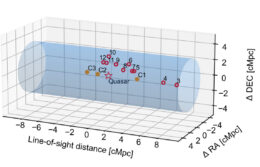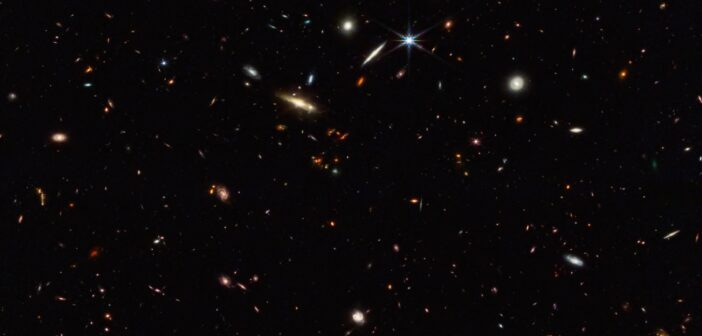JWST observations are poised to help astronomers study the surroundings of quasars — extremely luminous cores of galaxies in the early universe. The first analysis of a new survey of quasars reveals the structure of the cosmic web in the first billion years after the Big Bang.
Quasars in the Spotlight

An artist’s illustration of a young galaxy hosting a quasar: an extremely luminous galactic nucleus powered by a supermassive black hole. [S. Munro; CC BY 4.0]
Exactly how these supermassive black holes grew so quickly, bulking up to a billion solar masses in less than a billion years, is still up for debate. Researchers predict that in order for these black holes to reach their immense masses in such a short time, they must be located in areas densely populated with galaxies, where they’re constantly fed streams of cold gas.
Won’t You Be My Neighbor?
However, only some quasars in the early universe have been found to live in crowded regions. This might mean that the intense radiation from a quasar prevents galaxies from forming around it, or it might mean that the surrounding galaxies are simply very dusty, making them difficult to detect without a powerful infrared telescope.

An infrared JWST image of the field containing J0305–3150. The colored circles indicate the 41 newly identified reionization-era galaxies. Red galaxies are at approximately the same redshift as the quasar, while orange and magenta indicate galaxies at redshifts of z = 5.4 and 6.2, respectively. All other galaxies in the sample are in green. Click to enlarge. [Wang et al. 2023]
Feige Wang (University of Arizona) and collaborators introduced the first results of this survey, focusing on a quasar called J0305–3150.
Using JWST’s Near Infrared Camera (NIRCam), Wang and collaborators discovered 41 epoch of reionization galaxies in the field of view containing J0305–3150. And while previous observations found no sign of a galaxy overdensity, the new observations revealed three galaxy overdensities! One of the galaxy clumps is located at the same redshift as J0305–3150, suggesting that this quasar resides in a crowded neighborhood.
Signs of the Cosmic Web

A three-dimensional map of the galaxies located near J0305–3150. Galaxies identified via carbon emission lines are shown as orange circles while those identified via their oxygen emission lines are indicated with red circles. Click to enlarge. [Adapted from Wang et al. 2023]
The filament found in this work happens to be about the size of protoclusters seen in cosmological simulations. After comparing their results against the predictions from simulations, Wang and collaborators suggest that J0305–3150 and the galaxies that surround it could someday collapse into a massive galaxy cluster like those present in the universe today. This study gives us a first look into what the ASPIRE team will discover — stay tuned for observations of 24 more quasars!
Citation
“A SPectroscopic Survey of Biased Halos in the Reionization Era (ASPIRE): JWST Reveals a Filamentary Structure around a z = 6.61 Quasar,” Feige Wang et al 2023 ApJL 951 L4. doi:10.3847/2041-8213/accd6f

